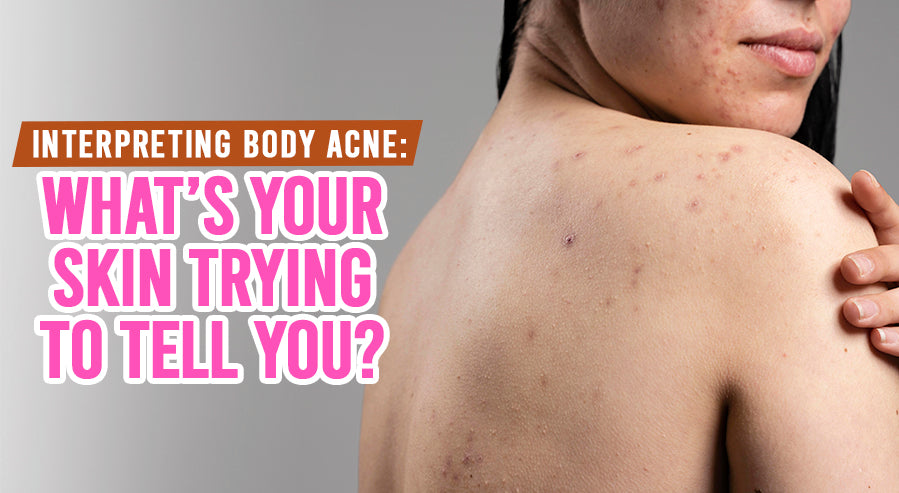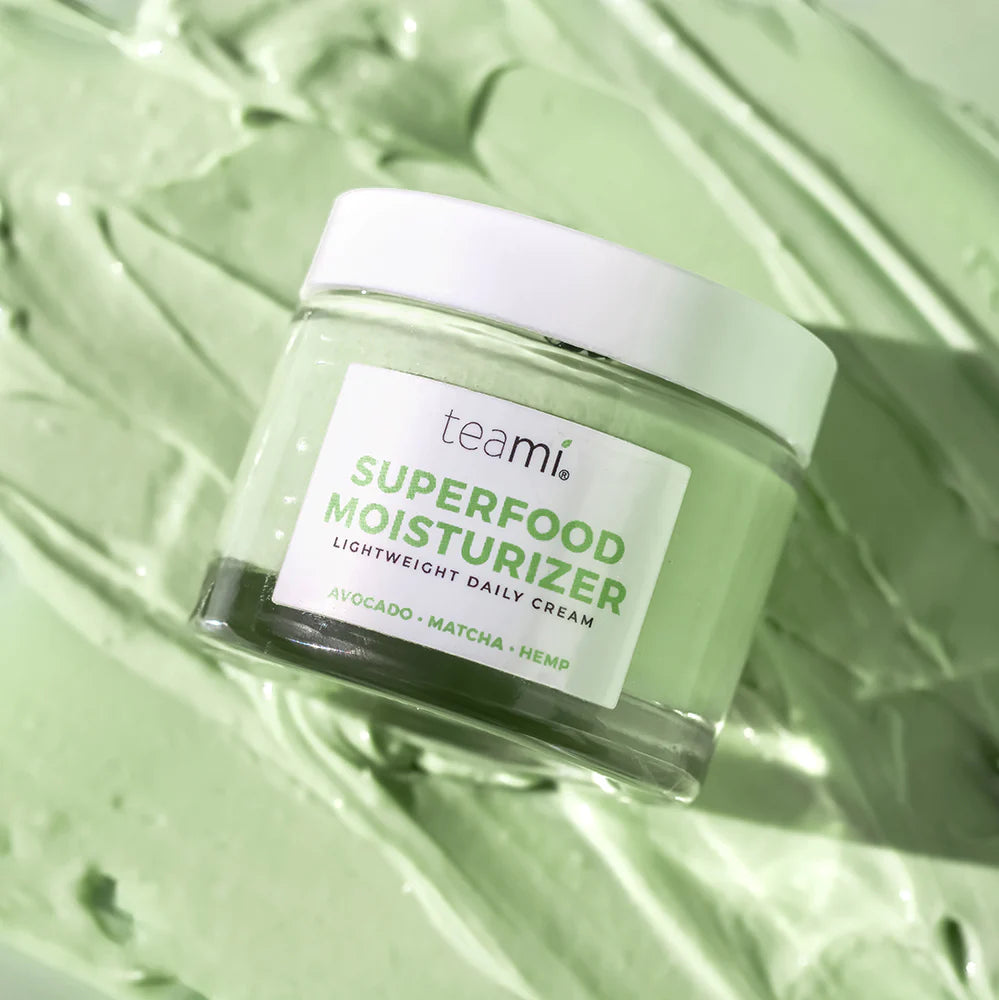Interpreting Body Acne: What's Your Skin Trying to Tell You?

Our skin is one of the more sensitive components of our physiology despite being the most exposed. Aside from protecting our organs from the elements, our skin is also one of the main aspects of our physical appearance. Skin color, texture, and moisture all impact our physical appearance and affect how we present ourselves to others. Many take pride in their appearance and want to care for it to avoid unpleasant blemishes.
Some skin blemishes that affect us are minor and will fade independently, whereas others are precursors to major illnesses. Fortunately, most fall into the former category, and extreme cases can be treated with certain cosmetic products. Unfortunately, one of the most common blemishes in skincare manifests in our youth and can persist well into adulthood if measures are not taken to counteract it.
Acne is, by and large, one of the most common blemishes in skincare and can affect anyone but usually starts during adolescence. Hormonal changes during our teenage years start the process that leads to the initial surge of acne, much to our chagrin, considering how important our appearances are to us at that age.
Whenever acne is mentioned, most focus on the appearance of pimples on the face since it is the most common site for that type of blemish. What most do not realize at first is that acne can manifest anywhere on the body that skin can be found. The question is: What does body acne mean?
What is Acne?
Acne is one of the most recognized skin conditions worldwide but is not necessarily understood by everyone who gets it. Teenagers often exaggerate acne as a major problem because of the vanity that runs rampant in high school environments. The reason is that acne is usually unpleasant to look at since it causes small pustules to form on the skin of varying sizes.
The most unpleasant of these pustules are whiteheads, so named for the white color at the tip of the pimple that reflects the pus beneath. Despite the disdain teenagers have for acne, the issue is extremely common, and over 9% of the global population (724,078,030 people) develop acne. The odds of acne are much higher during the teenage years because of the hormonal changes we experience during puberty. Unfortunately, this has caused a misconception that acne always fades once we reach a certain age and does not return to haunt us.

Many do not realize until later that hormonal imbalances do not solely cause acne and can affect adults long past puberty. Acne can be caused by several factors not restricted to individuals within a certain age group. As a result, some develop acne breakouts in later life that continue to chip away at their self-confidence. The impact of acne is exacerbated in individuals prone to major outbreaks that encompass a large portion of their skin.
These breakouts can inhibit their desire to be seen in public or interact with others, making acne one of the most hated skin conditions in existence. While facial acne is the biggest concern for most, there are other areas where acne can manifest and cause problems. The good news is that some types of body acne are hidden from view by clothing (though this is not always effective). The bad news is that acne is also usually somewhat uncomfortable or painful, depending on outbreak severity.
Types of Body Acne: Acne Mechanica
Body acne can appear on any limb where skin is present (which is all of them except the eyeballs). Most people quickly identify acne as a singular blemish that only varies in appearance with little else affecting the details. This misconception has caused issues for people trying to eliminate acne since misinformation inhibits skincare treatment. The truth is that several types of body acne have different catalysts.
Identifying these different types of acne is essential to understanding what your body needs to eliminate the blemish and restore a smooth complexion. One of the main types of body acne is acne mechanica, which only manifests under certain conditions but can appear on most body parts. Like all forms of acne, acne mechanica can manifest on our faces, but it is also commonly seen on the following body parts:
- Face
- Neck
- Arms
- Legs
- Torso
- Buttocks
You might assume that acne mechanica occurs when hormones are out of alignment, but the truth is that hormones have nothing to do with this type of acne. Acne mechanica appears due to the skin being exposed to excessive friction (i.e., rubbing, squeezing, or stretching).

While it is possible for a pre-existing acne condition to cause an acne mechanica outbreak, the latter can manifest without the former. There are several mundane objects and events that can cause an acne mechanica outbreak that you might not have considered before. The most common causes include:
- Shirts, especially those with collars.
- Sports gear like football and hockey equipment.
- Accessories like hats and bras.
- Medical equipment like casts and surgical tape.
- Rubbing your skin with your hands.
- Chairs and car seats.
Due to the nature of acne mechanica, athletes tend to have the highest risk of experiencing outbreaks. However, everyone is capable of experiencing an acne mechanica outbreak, but individuals who wear heavy sports equipment are more likely to experience friction and suffer an outbreak. Acne mechanica is more common than people realize, causing it to be misidentified as another type of body acne. Insofar as acne mechanica is concerned, your body is trying to tell you to change your style to reduce skin friction.
Unfortunately, it is not the only type that is worthy of attention.
Types of Body Acne: Acne Cosmetica
Acne cosmetica is another major body acne type with a specific catalyst associated with the outbreak. While acne mechanica is caused by friction, acne cosmetica is caused by applying cosmetic products to your skin. Cosmetics like makeup, lotion, and sunscreens can be very harsh on the skin and cause damage that allows contaminants to enter the dermal layer.
Most cases of acne cosmetica are caused when cosmetic products clog the pores and trap skin cells and other contaminants inside. Clogged pores are one of the main causes of acne outbreaks worldwide and account for the majority of cases. Many cosmetic products exacerbate the contamination of skin pores because of the ingredients used to make them. Specifically, many cosmetics use oils in their core ingredients that help create the ideal texture for the product.

Unfortunately, oil is one of the main contaminants contributing to acne breakouts, and applying it to your skin can worsen the issue. Furthermore, many cosmetic products contain silicones, contributing to whiteheads and dermal bumps. Acne cosmetica can be difficult to identify since you need to know which of your cosmetics are causing the outbreaks. As a result, the best way to counteract the condition is to discontinue the use of your cosmetics and take advantage of anti-acne products to eliminate the breakout.
Insofar as affected areas are concerned, acne cosmetica is typically restricted to predictable areas of the body. Since it is caused by applying cosmetics, you will only experience outbreaks on the body parts where you applied the products (i.e., the face and neck). In cases of acne cosmetica, your body is trying to tell you to stop using cosmetic tools that contaminate the pores.
Types of Body Acne: Acne Vulgaris
Another common type of body acne is acne vulgaris, which is actually the most common type since it is the easiest to generate. Unlike acne mechanica or acne cosmetica, acne vulgaris does not require heavy clothing or cosmetics to contaminate the skin. Instead, acne vulgaris occurs when certain aspects of our biology combine to contaminate the skin. Whenever the term acne is used, it refers to acne vulgaris since it is the common variant, whereas the others are more specialized.
Unfortunately, the commonality of acne vulgaris makes it our worst enemy since it can affect anyone at any age. Acne vulgaris outbreaks occur when the hair follicles in our skin are clogged with sebum (skin oil), skin cells, and bacteria. This contaminant mixture causes minor skin infections and allows whiteheads, pimples, and blackheads to form. This combination is easier for the body to produce during puberty since sebum production goes into overdrive when hormone levels change.
Specifically, our sebaceous glands (the glands responsible for producing sebum) take their cues from androgens. Androgens are major hormones primarily associated with our biological sex (testosterone for men and estrogen for women). Our body's production of androgens skyrockets during puberty, which causes the sebaceous glands to produce more sebum in correlation with this surge.
Unfortunately, our bodies need sebum to keep our skin hydrated, so we never stop producing it, making it possible for acne vulgaris outbreaks to recur in later life. Insofar as a bacterial infection is concerned, we are regularly exposed to microbial organisms because our environments are usually unpredictable. Unless you never leave the house and decontaminate everything that enters it, you will likely come in contact with bacteria at some point. The bacteria responsible for acne breakouts is Cutibacterium acnes, which thrives in oily skin and relies on the sebaceous glands to produce a viable environment on your skin.

While some people are naturally prone to producing more sebum, certain risk factors increase the odds of acne vulgaris outbreaks. Genetic factors are the main risk, but others are within our ability to control to varying degrees. These include:
- Diet: Many modern foods are cooked in fatty oils or deep fried, promoting sebum production and improving your skin as a home for bacteria. Furthermore, many processed foods elevate blood sugar levels and further enhance our susceptibility to acne vulgaris.
- Stress: When we are overstressed, our bodies respond in kind and cause chain reactions that affect our physiology. Emotional stress causes hormones to flare, producing sebum and triggering a breakout.
- Skincare Products: Like acne cosmetica, certain skincare products can clog follicles the same way that sebum can. Usually, this effect is caused by sunscreens and heavy moisturizers with thick textures. Not all skincare cosmetics produce this effect, but enough do to make it a valid concern.
Other risk factors are associated with acne vulgaris, but these are the few we can control to a certain extent. Acne vulgaris primarily affects the face and scalp since that is where most of our hair follicles reside. It sometimes affects other areas like the chest and groin since there are additional hair follicles. Regardless, acne vulgaris outbreaks still send a very clear message that you must heed if you want to reclaim your complexion.
Acne vulgaris is trying to tell you that you need to change certain aspects of your lifestyle and cleanse your skin. The latter can be particularly tricky since you might need a natural alternative to avoid clogging your pores further.
Finding the Right Blend
Acne is a consistent issue regardless of age and is exacerbated by certain lifestyle choices and skincare products. Treating acne can be difficult since some people are genetically prone to outbreaks, and some solutions can be harsh on the skin. Fortunately, there are natural methods for cleansing the skin and reducing the risk of outbreaks. Certain compounds can naturally purge our pores and hair follicles of contaminants without exacerbating the issue like certain pharmaceuticals might. The challenge is finding a product that can provide the desired effect from a reliable vendor.

We at Teami have always believed in the healing power of natural compounds and plants, which is why we have made it our livelihood. We have cultivated a catalog of natural skincare products to help you keep your skin healthy and vibrant while eliminating blemishes. One of our flagship products is our Gentle Superfood Liquid Cleanser, which uses natural compounds like Aloe vera and matcha to purge your skin of contaminants contributing to acne outbreaks. We encourage you to visit our website, try our products directly, and let us know what you think! After all, finding the right blend is a Teami effort.
Subscribe to our Newsletter
Subscribe to our newsletter and get 10% off your first purchase
 Instagram
Instagram



